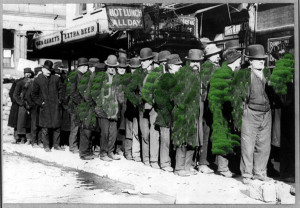A new study from the Brightsky Foundation has identified the single activity in American life that does the most to prevent emissions of gases that lead to global warming. The team of researchers and policy analysts who compiled the study also released a series of proposals to expand these salubrious activities and, they estimate, reduce the nation’s total emissions by 50% or more over a decade.
The study looked at what it called “non-optional activities,” meaning things people only do when they have to, such as taking out the garbage, getting a prostate exam, and answering calls from their parents. Emile Brouchad, a research scholar at the Brightsky Foundation and an adjunct professor of public policy at Gulf Isthmus University, explained that the team wanted to find activities with the greatest potential to effect behavioral change. “Look, no one’s going to change because we ask or they just think it’s a nice thing to do,” he said. “People could simply buy more efficient vehicles, which are cheaper and better for their daily use, but they don’t choose to do it. They want to feel like studs because they have rigs with giant tires and loud engines. To make a difference in climate change, we have to look at compulsory activities, not at what people choose to do.”
The researchers assessed each non-optional activity on three variables—direct carbon emissions, emissions saved by not doing more enjoyable activities, and “endurability,” meaning how long an average person can tolerate a given activity.
The clear winner: Waiting in line.
Waiting in line produces negligible carbon output. “Anyone who’s been in the queue at a movie theater knows that people in line do emit some gas,” says Brouchad. “But we figure they would have done that regardless, and so it doesn’t count.” Meanwhile, while people are waiting in line, they’re not driving, eating, exercising, boating, having sex, or engaging in any other enjoyable, carbon-emitting activity.
But it was on the endurability scale that lines really stood out. “The amazing thing about lines is that people are miserable, and yet they will go on in them forever,” says Brouchad. “Especially if you just give them some little reason for hope, like the line nudges forward, they go on taking it and taking it.”
 This quality made lines the perfect vehicle for a little social engineering. “We realized that more lines mean less greenhouse gas,” said Abigail Dunfrot, director of policy at the Brightsky Foundation. “So, by logical extension, more lines mean a better world. We have amazing potential to improve the world by just increasing the time people spend in lines.”
This quality made lines the perfect vehicle for a little social engineering. “We realized that more lines mean less greenhouse gas,” said Abigail Dunfrot, director of policy at the Brightsky Foundation. “So, by logical extension, more lines mean a better world. We have amazing potential to improve the world by just increasing the time people spend in lines.”
The report lays out a two-phase approach to making these improvements. The first leverages existing infrastructure. “It’s easy, we just reduce the number of people at the DMV counter. Every stadium, theater, amusement park, whatever, has fewer ticket takers. Your favorite little sandwich place, we take away half the sandwich makers,” says Dunfrot. “It’s critical that these changes be universal. If people can just drive a little further to avoid lines… well, you see the problem with that.”
The researchers project that these steps alone will reduce emissions by 18%.
The second phase introduces new technology and facilities to increase waiting times and line containment. For instance, new cash registers will add a 30 second delay before displaying totals. “We call it a universal mandatory waiting period,” says Dunfrot. The report also lays out a plan for the construction of extensive open-air containment facilities that will attach to all public facilities and utilize fencing and one-way gates to keep people from backing out of lines.
The report is likely to raise criticism from civil libertarians for using regulation to interfere in people’s personal lives. We described its main findings to Herman Vack, a research scholar at the Heritage Foundation. His first take was that the plan was “utterly un-American.” He said, “Our country was founded on liberty. Would the Founding Fathers have accepted this kind of compulsion? For themselves, I mean; not counting slaves. Right-thinking Americans today won’t accept it, either.”
But the plan’s advocates point out that waiting in line is already an inescapable fact of modern life, and that a mere 200-300% increase may prove palatable. “We expect there to be a period of adjustment,” says Dunfrot. “But the payoff will come when you reflect that some unknown future generation will have slightly more moderate temperatures and, just possibly, some drinkable water. And you’ll have plenty of time for that reflection.”


